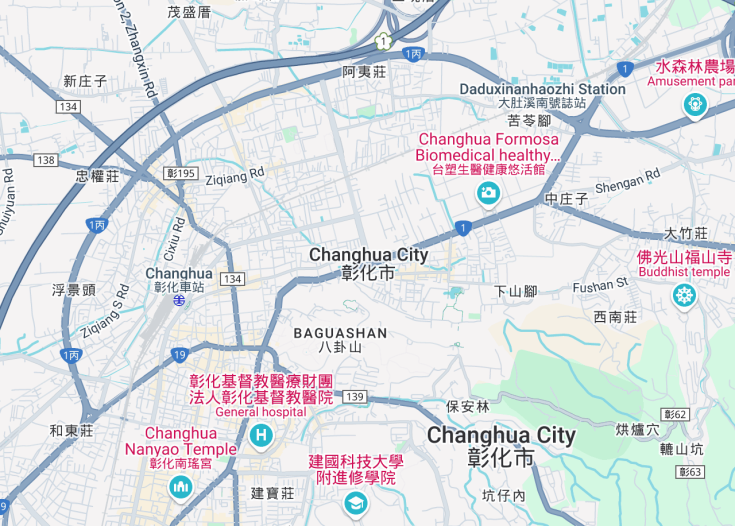Chiang-hòa-chhī, located in Taiwan, showcases an exquisite amalgamation of cultural heritage and modernity. This vibrant district attracts travelers with its rich tapestry of history, bustling night markets, and captivating scenic beauty.
Visitors can explore ancient temples, sample local delicacies, and immerse themselves in the warm, welcoming atmosphere of this unique locale. Chiang-hòa-chhī offers an intimate glimpse into the traditions and daily life of Taiwan, making it a must-visit for those seeking an authentic travel experience.
Be sure to explore the local night markets in Chiang-hòa-chhī, where you can indulge in street food delicacies and find unique handmade crafts.
Consider visiting during one of Chiang-hòa-chhī vibrant festivals to fully experience its rich cultural tapestry and traditions firsthand.
Top things to do & see in Chiang-hòa-chhī
Select the following sights and activities to discover best tickets and tours available in Chiang-hòa-chhī.
Chiang-hòa-chhī: A Cultural Tapestry
| Country | Taiwan |
| Time in Chiang-hòa-chhī | GMT+8 |
| Language spoken | Hokkien |
| Population | 223,459 (according to the latest statistical data) |
| Currency | New Taiwan Dollar (NT$ / TWD) |
| Airports |
|
Chiang-hòa-chhī, located in the heart of Taiwan, boasts a rich tapestry of culture and history that dates back several centuries. Known historically as Chiayi, it was once a bustling hub for agricultural trade.
Today, it serves as an essential gateway to the enchanting Alishan mountain range, making it a favorite amongst tourists seeking natural beauty and serenity. Its deep-rooted heritage is evident in its well-preserved temples, traditional festivals, and vibrant local cuisine that provides a taste of authentic Taiwanese culture.
Where is Chiang-hòa-chhī?
Chiang-hòa-chhī is strategically situated on the plains of the western part of Taiwan, making it accessible by road and rail from major cities.
Distances:
| Route | Distance by car | Time by car |
|---|---|---|
| Taipei to Chiang-hòa-chhī | 170 miles (275 km) | Approximately 3 hours, 30 minutes |
| Taichung to Chiang-hòa-chhī | 100 miles (160 km) | Approximately 2 hours |
What is Chiang-hòa-chhī famous for?
Chiang-hòa-chhī is famous for its pivotal role in the development of Taiwan’s sugar and timber industries. Today, its cultural significance and access to the breathtaking Alishan National Scenic Area continue to enchant visitors and locals alike.
History
Prehistoric Era to Dutch Colonial Rule (Before 1624)
The region now known as Chiang-hòa-chhī was originally inhabited by indigenous peoples who belonged to the Austronesian ethnic group. These communities thrived on the island’s abundant natural resources, establishing a rich cultural tapestry that predates major external influences.
The Dutch Period (1624-1662)
In 1624, the Dutch East India Company established a presence in Taiwan, marking the beginning of significant foreign influence in the area. They introduced new technologies and agricultural methods, leaving a lasting impact on local social and economic structures. Chiang-hòa-chhī saw limited direct influence but served as a peripheral area for trade and cultural exchange.
Qing Dynasty Rule (1683-1895)
When the Qing Dynasty took control of Taiwan in 1683, Chiang-hòa-chhī experienced increased development. The area became a center for agriculture, particularly sugarcane and rice, supported by the imperial need for these commodities. During this period, significant migration from mainland China occurred, introducing further cultural and demographic changes to the region.
Japanese Occupation (1895-1945)
Taiwan’s cession to Japan following the First Sino-Japanese War brought a new wave of changes to Chiang-hòa-chhī. The Japanese focus on modernization introduced railways, public education, and enhanced infrastructural development. However, these advances were accompanied by strict control over political and cultural life, suppressing native traditions and movements.
Modern Era (1945-Present)
Post-World War II, Chiang-hòa-chhī became part of the Republic of China. The ensuing decades have seen the region transform into a vibrant part of Taiwan, characterized by a booming economy, vibrant cultural scene, and active political engagement. Today, Chiang-hòa-chhī blends its rich historical heritage with modern advancements, making it an important cultural and economic hub in Taiwan.
Visit Chiang-hòa-chhī
What to see and do in Chiang-hòa-chhī, Taiwan
Chiang-hòa-chhī offers a blend of historical landmarks and natural beauty. Visitors can explore a variety of attractions:
- Historical Museums – Gain insights into the area’s rich past
- Nature parks – Ideal for hiking and observing local flora and fauna
- Local markets – Experience the vibrant local commerce and crafts
Chiang-hòa-chhī provides a rich tapestry of activities suited for all types of travelers.
Festivals and Events in Chiang-hòa-chhī
Chiang-hòa-chhī hosts several annual festivals and events that reflect its diverse cultural heritage. Notable events include the Spring Harvest Festival, which celebrates local agriculture in April, and the Moon Festival, featuring lantern displays and gatherings in September.
These events offer a glimpse into the traditions and community spirit of Chiang-hòa-chhī.
Best time to visit Chiang-hòa-chhī
The best time to visit Chiang-hòa-chhī is during the autumn months from September to November. During this period, the weather is pleasantly cool and dry, providing ideal conditions for exploring outdoor attractions and participating in local festivals.
Is Chiang-hòa-chhī worth visiting?
Chiang-hòa-chhī is undeniably worth a visit for those intrigued by a unique blend of history and nature. While the region offers a profound historical context and beautiful landscapes, prospective visitors should be prepared for occasional rainfall and high humidity, especially in summer months.
Nonetheless, the cultural richness and welcoming nature of its inhabitants make Chiang-hòa-chhī a noteworthy destination in Taiwan.









